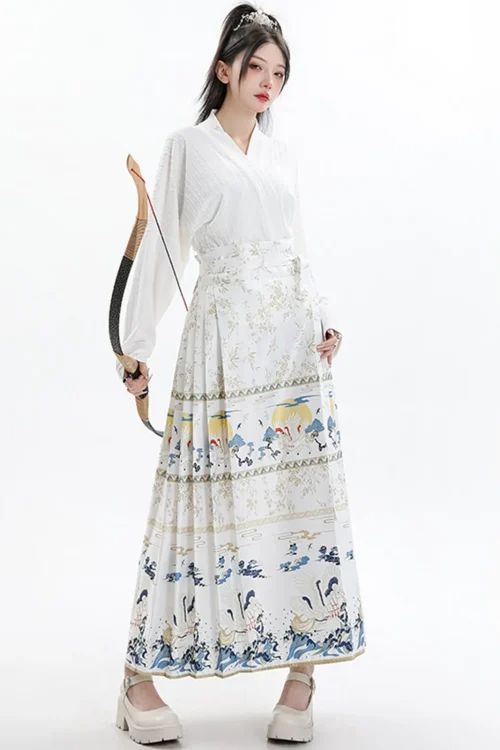Dior’s Homage to the 马绵群: A Cultural Exploration
Dior’s latest collection pays homage to the mǎmiànqún, a traditional Chinese garment that embodies elegance and cultural heritage. The collection, unveiled in Paris, seamlessly blends Eastern and Western aesthetics, showcasing the enduring influence of Chinese fashion on the global stage.

Historical Context
The mǎmiànqún, literally meaning “马面裙,” originated during the Qing dynasty and was worn by Manchu women. Its distinctive features include a high waist, pleated front, and intricate embroidery. Dior’s creative director, Maria Grazia Chiuri, drew inspiration from this iconic garment, reinterpreting its elements with a modern twist.
Design Elements
The collection features flowing silhouettes, delicate fabrics, and exquisite embroidery. The high waists and pleated skirts evoke the mǎmiànqún’s traditional form, while the use of sheer fabrics and contemporary embellishments adds a touch of modernity. The embroidery, a hallmark of Chinese craftsmanship, is meticulously executed, featuring motifs of flowers, birds, and auspicious symbols.
Cultural Significance
Beyond its aesthetic appeal, the collection also carries cultural significance. By incorporating elements of the mǎmiànqún, Dior acknowledges the rich history and artistry of Chinese fashion. It serves as a bridge between two distinct cultures, fostering dialogue and appreciation.
Critical Reception
The collection has been met with critical acclaim, praised for its elegance, craftsmanship, and cultural sensitivity. It has not only captured the attention of fashion enthusiasts but also sparked a broader conversation about the importance of preserving and celebrating cultural heritage.
结论
Dior’s homage to the mǎmiànqún is a testament to the enduring power of fashion as a means of cultural exchange. It demonstrates the ability of fashion to transcend boundaries, inspire creativity, and foster a deeper understanding of different cultures. As the collection travels from Beijing to Paris, it carries with it a message of appreciation, respect, and the enduring legacy of Chinese fashion.
The Evolution of the Mǎmiànqún: From Beijing to Paris
Dior’s recent collection, unveiled in Paris, paid an elegant homage to the traditional Chinese garment, the mǎmiànqún. This iconic piece, originating from Beijing, has undergone a remarkable evolution, captivating the fashion world with its timeless allure.

Historical Significance
The mǎmiànqún, literally meaning “horse-face skirt,” is characterized by its A-line silhouette, high waist, and intricate pleating. Its origins can be traced back to the Qing dynasty, where it was worn by Manchu women as an undergarment. Over time, it evolved into an essential part of the traditional Chinese wardrobe, worn by women of all ages and social classes.
现代 Interpretation by Dior
Dior’s creative director, Maria Grazia Chiuri, drew inspiration from the mǎmiànqún’s rich history and cultural significance. The collection featured a range of pieces that reinterpreted the garment in a modern and sophisticated manner. From flowing silk dresses to tailored jackets, each design showcased the mǎmiànqún’s signature pleating and A-line shape.
Versatility Highlighted
Chiuri’s designs not only paid homage to the mǎmiànqún’s heritage but also highlighted its versatility. The collection included pieces suitable for both formal and casual occasions, demonstrating the garment’s adaptability to different contexts. The use of luxurious fabrics, such as silk and lace, added an element of elegance and refinement.
Enduring Appeal
The evolution of the mǎmiànqún from Beijing to Paris is a testament to its enduring appeal. Dior’s collection has brought this traditional Chinese garment to the forefront of contemporary fashion, showcasing its timeless beauty and cultural significance. By reinterpreting the mǎmiànqún in a modern and sophisticated manner, Chiuri has ensured that this iconic piece continues to inspire and captivate generations to come.
The Influence of Chinese Culture on Dior’s Designs
Historical Connections
Christian Dior’s fascination with Chinese culture has left an enduring mark on the fashion house’s designs. In recent years, this influence has been particularly evident in the reinterpretation of the traditional Chinese garment, the mǎmiànqún.

Origins of the Mamianqun
The mǎmiànqún, literally meaning “horse-face skirt,” is a pleated skirt characterized by its high waist and A-line silhouette. Its origins can be traced back to the Qing dynasty, where it was worn by Manchu women as part of their formal attire.
Early Inspiration
Dior’s first encounter with the mǎmiànqún came during a visit to Beijing in 1947. Captivated by its elegant lines and intricate pleating, he incorporated elements of the garment into his own designs. In the 1950s, Dior’s “New Look” featured full skirts that echoed the shape of the mǎmiànqún.
21st Century Embrace
However, it was not until the 21st century that Dior fully embraced the mǎmiànqún as a source of inspiration. In 2012, then-creative director Raf Simons presented a collection that featured a series of mǎmiànqún-inspired skirts. These skirts were crafted from luxurious fabrics such as silk and organza, and adorned with intricate embroidery and beading.
Continuation of Tradition
Simons’ successor, Maria Grazia Chiuri, has continued to explore the mǎmiànqún’s potential. In her 2019 collection, she presented a range of mǎmiànqún-inspired dresses and skirts that combined traditional Chinese elements with modern silhouettes. These garments featured bold colors, geometric patterns, and asymmetrical cuts.
结论
Dior’s interpretation of the mǎmiànqún has not only paid homage to Chinese culture but has also demonstrated the enduring relevance of traditional garments in contemporary fashion. By reinterpreting the mǎmiànqún in a modern context, Dior has created garments that are both elegant and timeless.
The influence of Chinese culture on Dior’s designs is a testament to the power of cultural exchange and the enduring appeal of traditional garments. As Dior continues to draw inspiration from China, we can expect to see even more innovative and beautiful creations that bridge the gap between East and West.
